If you don’t like taro, I don’t know if we can be friends.
I used to be aghast when people asked me what taro was. It’s a root, like potato, you know? Then slowly I realized that I was the obnoxious one for not realizing that not everyone is Vietnamese. But when you grew up with something so abundant, don’t you get the feeling that everyone else must have grown up with it too? Next time someone says “What, you haven’t seen Star Trek?!”, I’m gonna ask “have you eaten taro?”. (Just my luck, they’d say yes and I’d have to go to Blockbusters. :D)
To be fair, Vietnam is not the only country that has taro in its kitchens, the roots are also in China, India, Korea, Japan, Cameroon, you name it. But to this Vietnamese taro-fan, it’s Vietnamese heart and soul. It’s not recognized everywhere, but its growth spreads everywhere. It adapts easily in both sweet and savory dishes. Its sweetness lies somewhere between the red sweet potato and the usual potato. It’s nutty like boiled peanuts in some parts, dense and moist like cassava in others.
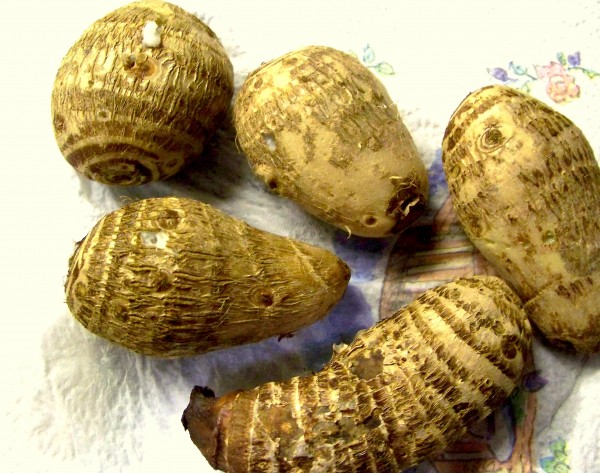
It’s not pretty (are roots ever pretty?). It’s hairy, brown, with several nodes and spots. It can cause a slight itch if washed with bare hands. Most small taros are just a tad bigger than a chicken egg. The only thing I know how to do with them is to boil them, like eggs, for roughly 30 minutes (from cold water). Then I peel them while they’re still warm, dip them into sugar, and savor their nuttiness.
Actually, the taro here doesn’t taste that great. It’s too bland, too mushy, too dense, and it barely tastes like taro. Back home, Little Mom used to make taro soup (canh khoai môn): chunky slices of taro, chopped green onion, pork, dried shrimp (tôm khô), water, salt and sugar to taste. There might have been a teaspoon or two of fish sauce and fish sauce to taste. It’s my favorite canh, and my grandfather’s too. But Little Mom doesn’t make it anymore because 1. she doesn’t like taro in its root form, and 2. she doesn’t like taro in the States.
She does like taro as a flavor in sweets, though. Once a week, we used to get a half-kilo tub of Wall’s taro ice cream, its soft lavender color was as sweet and alluring as its taste. How I long for the day when Häagen-Dazs churns out the magic purple so that I don’t have to settle with the ink-dyed Magnolia’s or wait at the mercy of Yogurt Land‘s customers. Apparently, taro frozen yogurt tops the worst-seller list in downtown Berkeley and only gets served when the other flavors are out. And I thought Berkeleyans were the adventurous type. FYI, taro pairs best with coconut.
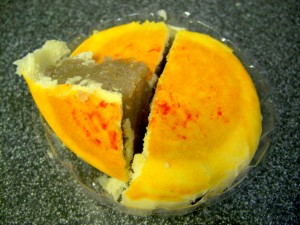
When taro is added into plain things, like yogurt, it adds flavors. When it’s added into sweet things, like mooncake and pudding (chè), it moderates the sugar and adds texture. Bánh bía khoai môn (Suzhou mooncake with taro filling) is less sweet than its common mung bean counterpart (bánh bía đậu xanh). Chè khoai môn (taro in sticky rice pudding) is a harmonious mix of chunky and soft, of nutty and chewy, of plain, salty and sweet.
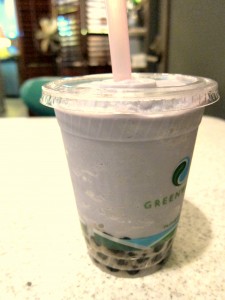
Through the internet grapevines, I’ve also heard of bánh da lợn khoai môn (taro pig-skin pie), bánh đúc khoai môn (taro rice jelly cake) with meat and dried shrimp, fried rice with taro, taro hushpuppies dipped into sweet and sour fish sauce. But if I ever get a real kitchen, the first thing I make with taro will be a bowl of soft, milky steamed taro cake (bánh khoai môn hấp), and I’ll get a cuppa taro bubble tea to complete my love.
Will they make taro milk one day?
More taro-ness: Taiwanese taro pastry
This post is submitted to Delicious Vietnam #15, July edition, hosted by Lan from Angry Asian Creations.
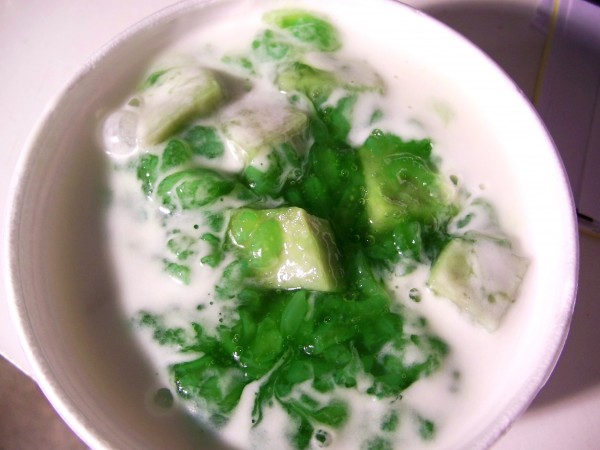

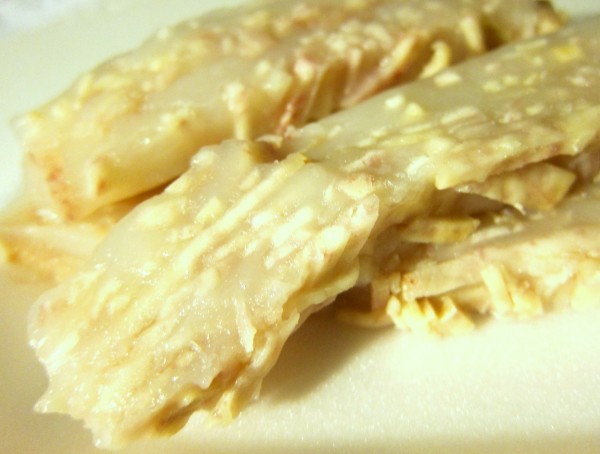



Nè cưng, con da quên rang hồi còn ở bên nhà, má nấu canh khoai môn khong phai chi voi tôm khô mà còn co thit nac hoac sườn heo nua , và má cung khong can dung muoi voi đường neu đã nêm canh bang nuoc mam .Nguoi ta cung dung khoai môn để nhồi vào trong món vit hầm và tán nhuyễn khoai môn de lam nhân chả giò nua. Nhưng con noi rat đúng là má chỉ thich khoai môn trong món chè khoai và món kem hoac yogurt mà thôi.:)
Thank you, Mom. I’ve updated the taro soup ingredient list. 🙂
I am more used to it in Oden (Japanese Stew). I have no reference for it as a sweet, I need to get some Taro Ice Cream!
Yum! I love taro, too! In fact, I have a couple in the fridge right now, waiting to be cooked with vịt nấu chao 🙂
I haven’t had taro in oden yet, do you cut them up in big chunks? What kind of meat do you use with it?
Mmmm I love chao, too! 😀
My family has always used satoimo (taro root) in holiday oden. We peel it and use medium sized chunks. You have to be careful when you add it, as it will dissolve if over-cooked even a little.
Ha wow, I haven’t thought about taro dipped in sugar since I left VN.
One of my favorite canh is taro based, too – canh rau muong with pork ribs and taro.
@Bob: that’s really interesting, I always thought that taro was pretty resilient, at least more than sweet potato. The outer layer may gets quite milly/mushy if overcooked but there’s a dense and chewy core that always remains intact, so that it doesn’t dissolve. I need to study the different kinds of taro.
@Dang: your comment makes me think of how among the tubers, only taro and potato make it into canh, but actually we call it súp when it has potato. There’s no canh with sweet potato or cassava, right?
There’s canh khoai mỡ, too. Mashed khoai, shrimp (or meat?) and no leafy vegetables, just garnished with rau om, iirc.
Great post. I’m among the Taro faithful and love it in all it’s forms. Among my favorites are the taro root puffs at Dim Sum places. I also love the flaky yet moist purple buns at Chinese bakeries that contain taro. So good!
@Dang: you’re right, my mom just told me that she made canh khoai mỡ when I was little, but I don’t remember anything about it. From the name I can only guess that it’s mushier and slicker than taro, is that right?
@Rob: I know the flaky yet moist taro buns you’re talking about. 🙂 I wonder how taro would fare in a pie, or if one can make taro icing for cakes (and cupcakes). 🙂
i agree, if you dont like taro, i’m sure we cant be friends.. but if you love taro, we can probably get married
i like the taro and sticky rice with coconut milk dessert.. from Vietnam.. does that use sweetened condensed milk + coconut milk, or only coconut milk? i’m still figuring that one out
the other one I love is the Filipino desert with Taro, Sago, Purple Sweet potato, & Banana, with Coconut milk.. thats one of my all time favorites
try this, cook and peel the taro, then cube it, then eat it with vanilla ice cream.. or with milk and sugar like ceral
or, grate it up and make taro hash-browns for breakfast, just mix sugar, salt & White pepper then fry it up.
or, my all time favorite.. Poi!!!… just bake it well, then peel it, then run it through a food processor a few times adding a little water as needed until its a smooth paste, just eat it with anything, or use it as an ingredient in other things, like adding it to your regular Pancake mix.. mmmm
@ Mai, Taro Pies? umm McDonald’s makes a great Taro pie, its the only reason worth going to McDonalds, and if not for that Taro Pie I wouldnt ever go there..
Just Peel the Taro, then boil it with some water & Sugar, and little Lemon Juice, then add cornstarch slurry to thicken it up, then bake it in a nice pie crust same as any fruit Pie, only you can use a very flaky pie crust, because the taro mixture isnt overly moist and wont release extra water or juice during cooking.. be sure to use a top crust too, because the best part of the taro is eating it with the sugared crust.. and eat it with vanilla ice cream.. taro and vanilla together is WAY better than taro ice-cream
and that filipino one, just boil the taro, when its tender then add the Sago, cook til the Sago or Tapioca is transparent, then add the Sugar and Banana and Stir in the coconut milk, and cook til its all hot, then eat it hot, or cool it and eat it cold..
Thanks for the tips, David! Poi sounds like a good ingredient for pancakes. Actually, that just gave me some new ideas to try.
The Vietnamese taro che uses coconut milk only as a final touch after the pudding is made, and no condensed milk.
I love it too. Just so you know, it is widely cultivated in the Caribbean, at least in Puerto Rico, which is where I live. And the chunks are so huge… We call it Malanga, or Malanga Lila (which indicates its purple color). I love to eat it like a mashed potato, with just garlic and olive oil.
That sounds lovely! Sometimes when I don’t have time to cook, I just boil taro and eat it with sugar. 🙂
Wonderful, what a web site it is! This blog gives useful facts to us,
keep it up.
[…] but I definitely have pre-conceived notions about what veggies should taste like. Taro is used in tons and tons of dishes, both sweet and savory. I’ve heard it goes well with rice (note the absence of mung […]